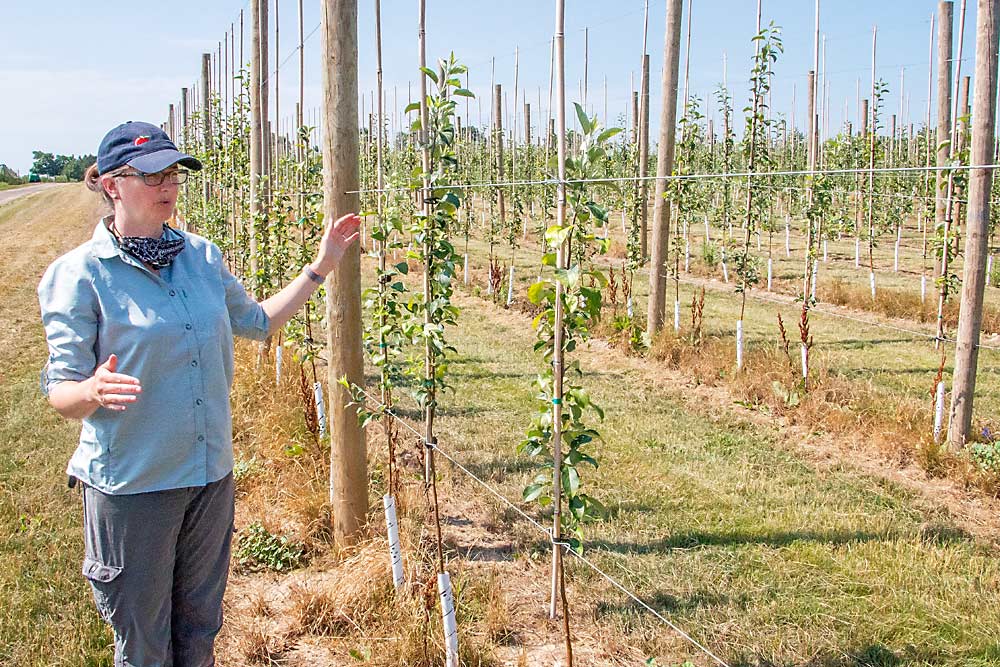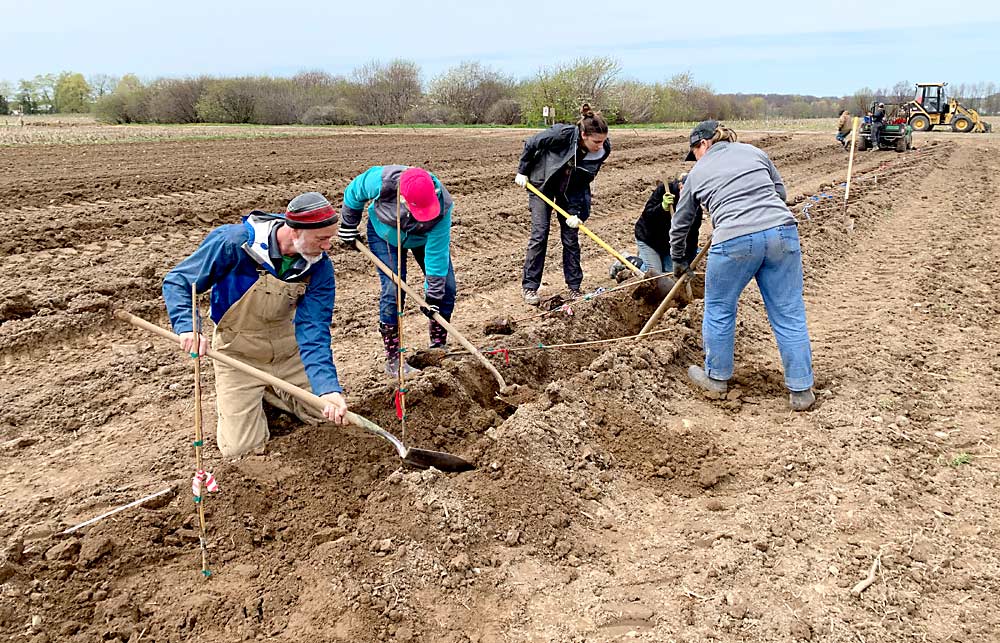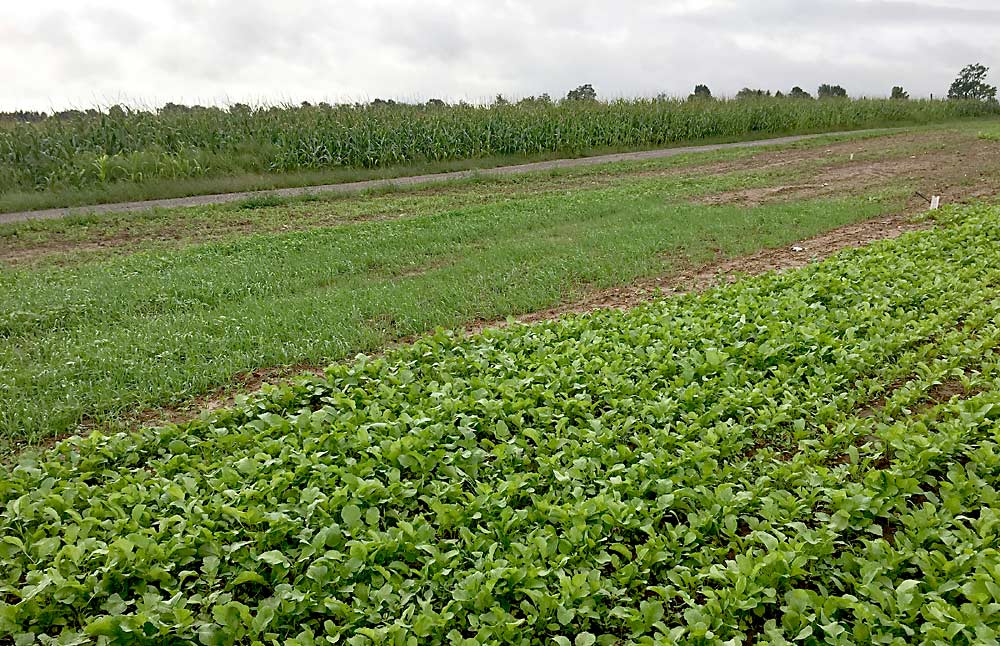
Unlike their colleagues in the Pacific Northwest, Michigan apple growers traditionally have not worried too much about apple replant disorder. But researchers want to see if perhaps they should.
The condition, which occurs when new trees are planted where old trees once grew, suppresses the growth of the new trees and can lead to an early decline in their health, said Julianna Wilson, a tree fruit specialist with Michigan State University. The newly planted trees fail to thrive in the soil: They have a harder time withstanding stress and their canopies don’t develop fully, which affects their fruit yields.
Replant disorder — often called replant disease, but more accurately referred to as a disorder because it has multiple causes — has been intensively studied in the Pacific Northwest, where growers typically deal with it by fumigating soil before replanting. The problem hasn’t been nearly as severe in Michigan, but it also hasn’t received much research attention, said Todd Einhorn, an MSU tree fruit physiologist.
“We don’t know how prevalent the disorder is or its severity on newly established trees,” Einhorn said.
Wilson agreed.
“We don’t know the extent of the problem,” she said. “There hasn’t been panic about it, but it’s becoming more of an issue. A lot of Michigan growers have questions.”
But the answers won’t necessarily be supplied by the lessons learned in the arid Northwest. Michigan growers, and growers in the broader Great Lakes region, need answers grounded in their own specific soil and environmental conditions. That’s why Wilson started the Michigan Apple Replant Project a few years ago.
The causes of replant disorder are complex. According to Wilson, Einhorn and MSU nematologist Marisol Quintanilla, many factors contribute, including plant-parasitic nematodes and soilborne pathogens. Soil fertility and chemistry imbalances also are factors. Wilson said old apple trees contribute to the problem by leaving behind residues that suppress the growth of their own kind.
Michigan’s accelerating transition from older, low-density orchards to newer, high-density orchards exacerbates the potential for problems. Small, modern trees on vigor-suppressing rootstocks are more likely to be sensitive to replant disorder, Wilson said.
The big root systems left over from the old trees can support huge amounts of fungi, pests and pathogens — including nematodes, which are known to play a role in replant disorders in most fruit and nut trees. For apple growers, nematodes tend to be more of a problem in sandy soils. Root lesion nematode, dagger nematode, and ring nematode do more damage to apple trees than do other species. Some species, such as dagger nematode, can also be a vector for viruses, Quintanilla said.
When planting a new orchard where an old one used to be, growers are typically advised to plant the new tree rows in the old drive rows, not on top of the old root systems. But when you’re going from a spacing of 15 feet between rows to a spacing of 11 or 12 feet, there’s going to be some overlap. Previous research has shown that such overlap can lead to early tree decline or failure to thrive, Wilson said.

Field trial
With financial support from the Michigan Apple Committee, the Michigan State Horticultural Society, the Michigan Tree Fruit Commission, and MSU’s Project GREEEN, Wilson’s team set up a replicated field trial at MSU’s Clarksville Research Center and planted new high-density trees on an old apple block. The goal is to test a variety of preplant practices on the new block and measure their cumulative impact on the productivity of the new trees.
With advice from Einhorn, Wilson chose Honeycrisp as the trial’s variety, because it’s popular and profitable. They decided to use two rootstocks: Budagovsky 9, a standard rootstock for Honeycrisp in Michigan, and Geneva 214, which is more vigorous and supposedly more resistant to replant disorders.
Wilson’s team decided on seven preplant treatments (each replicated six times) for the block:
—Leaving soil fallow for one year, which is the minimum recommendation before planting back to apples.
—Planting soybeans for one year. It’s common for Michigan growers to plant a cash crop in between orchard plantings, but soybeans carry the risk of increasing plant-parasitic nematodes.
—Planting black oats for one year. This cover crop is not known to host plant-parasitic nematodes of consequence to apples.
—Planting oilseed radish. When incorporated into the soil, this cover crop acts as a biofumigant.
—Using herbicide to kill old trees before removing them (to reduce the number of live roots), followed by fallowing.
—Using herbicide to kill old trees before removing them, followed by black oats.
—Immediate replant. Old trees were removed in the fall just prior to planting the new orchard the following spring.

The new trees were planted in 12 rows in May 2019, on 3-feet by 11-feet spacing. The old orchard had a 15-foot spacing, so the new rows overlap both old tree rows and old grass alleys. Posts, trellis wire and drip irrigation were installed soon after, according to Wilson.
There are 10 trees per replicate of each rootstock in the Clarksville block, and all the trees are trained to a tall spindle design, Einhorn said.
The recommended practice of leaving a field fallow for a year — or planting it with a cover crop — after removing an old block is probably more common in Michigan, but financial pressures sometimes cause growers to replant immediately the following spring, Wilson said.
They decided against including a chemical fumigant treatment, because the ability of a fumigant to suppress pathogens and nematodes is temporary. Moreover, the broad-spectrum effects could damage the diversity of the soil microbial community, which could have adverse effects on tree health, she said.
Wilson’s team will follow the trees for about five years, through the first full year of production. They’ll study the effects of the different treatments on tree outcomes. Already, in the first year after planting, they’ve seen some differences in growth: The G.214 rootstock, in general, grew faster than the Bud.9, she said. •
—by Matt Milkovich






Leave A Comment